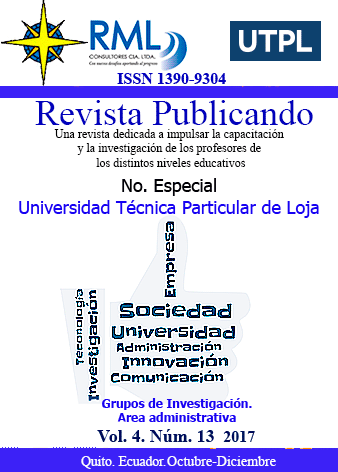Abstract
La Ley de Okun continúa siendo utilizada para analizar la relación entre el desempleo y la producción de una economía. Latinoamérica está caracterizada por economías no extensivas en empleo, por lo cual la presente investigación compara la respuesta del desempleo al crecimiento económico, en 12 países de América Latina mediante la ley de Okun. Para el análisis de causalidad de las variables se utilizó un modelo VAR de datos de Panel y para investigar la relación a largo plazo se utilizó pruebas de cointegración y raíces unitarias. El resultado demuestra que se para los países de América Latina existe una relación inversa entre el desempleo y el crecimiento. Además, el desempleo de un periodo influye en el desempleo del siguiente periodo y a diferencia de estudios previos que dan una variación de cerca del 3% en nuestro estudio la variación estimada es de 1%.References
Arias, E., Kikut, A. C., y Madrigal, J., (2002). Estimación de la ley de Okun para Costa Rica. Nota Técnica.
Ballabriga, F. C., (1991). Instrumentación de la metodología VAR. Banco de España.
Banco Internacional de Desarrollo, (2016). Nuevas tendencias en los tratados comerciales en América Latina. Módulo I.
Banco Mundial, (2013). World development report 2013: Jobs. World Economic Forum.
Banco Mundial, (2017). World development report 2017: Jobs. World Economic Forum.
Beaton, K. (2010). Time variation in Okun's law: A Canada and US comparison (No. 2010, 7). Bank of Canada Working Paper.
Blanchard, O. J., y Summers, L. H., (1986). Hysteresis and the European unemployment problem. NBER macroeconomics annual, 1, 15-78.
Cuaresma, J. C., (2003). Okun's law revisited. Oxford Bulletin of Economics and Statistics, 65(4), 439-451.
Dao, M. y Loungani P., (2010). The Human Cost of Recessions: Assessing It, Reducing It. IMF Staff Position Note, SPN/10/17.
DoÄŸru, B., (2013). The link between unemployment rate and real output in Eurozone: A panel error correction approach. Procedia-Social and Behavioral Sciences, 99, 94-103.
Elshamy, H., (2013). Okun”™s law and its validity in Egypt. Journal of Emerging Issues in Economics, Finance and Banking, 1(2), 67-74.
Evans, G. W., (1989). Output and unemployment dynamics in the United States: 1950–1985. Journal of Applied Econometrics, 4(3), 213-237.
Freeman, D. G., (2001). Panel tests of Okun's law for ten industrial countries. Economic Inquiry, 39(4), 511-523.
Gí¶cke, M., (2002). Various concepts of hysteresis applied in economics. Journal of Economic Surveys, 16(2), 167-188.
Gordon, R. J., y Clark, P. K., (1984). Unemployment and Potential Output in the 1980s. Brookings Papers on Economic Activity, 1984(2), 537-568.
Guerrero, C., (2007). Evolución reciente y perspectivas del empleo en el Istmo Centroamericano, Serie estudios y perspectivas, Unidad de Desarrollo Económico, CEPAL.
Hadri, K., (2000). Testing for stationarity in heterogeneous panel data. Econometrics Journal 3(2), 148–161.
Holmes, M. J., y Silverstone, B., (2006). Okun's law, asymmetries and jobless recoveries in the United States: A Markov-switching approach. Economics Letters, 92(2), 293-299.
Holtz-Eakin, D., Newey W., y Rosen H.S., (1988). Estimating vector autoregressions with panel data. Econometrica, 56(6), 1371-1395.
Huang, H. C. R., y Chang, Y. K., (2005). Investigating Okun's law by the structural break with threshold approach: Evidence from Canada. The Manchester School, 73(5), 599-611.
Jaeger, A., y Parkinson, M., (1994). Some evidence on hysteresis in unemployment rates. European economic review, 38(2), 329-342.
Jardin, M., y Gaétan, S., (2011). How Okun”™s law is non-linear in Europe: a semi-parametric approach. Rennes, University of Rennes.
Lal, I., Muhammad, S. D., Jalil, M. A., y Hussain, A., (2010). Test of Okun”™s law in some Asian countries co-integration approach.
Lee, J., (2000). The robustness of Okun's law: Evidence from OECD countries. Journal of macroeconomics, 22(2), 331-356.
León-Ledesma, M.A., (2002). Unemployment Hysteresis in the US and the EU: A Panel Data Approach. Bulletin of Economic Research, 54 (2), pp.95-103.
Levin, A., Lin, C.F., y Chu, C.S., (2002). Unit root tests in panel data: Asymptotic and finite-sample properties. Journal of Econometrics 108 (1), 1–24.
Mitchell, W. F., (1993). Testing for unit roots and persistence in OECD unemployment rates. Applied Economics, 25(12), 1489-1501.
Nelson, C. R., y Plosser, C. R. (1982). Trends and random walks in macroeconmic time series: some evidence and implications. Journal of monetary economics, 10(2), 139-162.
Okun, A.M., (1962), “ Potential GNP: Its Measurement and Significance,” Proceeding of the Business and Economics Statics Section o the Americans Statistical Association: 98-104
OMC (2017) Organization Mundial de comercio. Estadísticas. Recuperado de: https://www.wto.org/spanish/tratop_s/region_s/region_s.htm (accesado el: 05/05/2017)
Paéz - Cortes, J. N., (2013). Una revisión de la ley de Okun para Latinoamérica (Doctoral dissertation).
Pérez-Navarro, M., (2009). Caracterización y estimación de factores asociados a tuberculosis pulmonar en pacientes con y sin diabetes mellitus del Estado de Veracruz.
Prachowny, M. F., (1993). Okun's law: theoretical foundations and revised estimates. The review of Economics and Statistics, 331-336.
Sadiku, M., Ibraimi, A., y Sadiku, L., (2015). Econometric Estimation of the Relationship between Unemployment Rate and Economic Growth of FYR of Macedonia. Procedia Economics and Finance, 19, 69-81.
Silvapulle, P., Moosa, I. A., y Silvapulle, M. J., (2004). Asymmetry in Okun's law. Canadian Journal of Economics/Revue canadienne d'économique, 37(2), 353-374.
Sí¶gner, L., y Stiassny, A., (2002). An analysis on the structural stability of Okun's law--a cross-country study. Applied Economics, 34(14), 1775-1787.
Soriano, B., y Garrido, A., (2016). How important is economic growth for reducing undernourishment in developing countries? Food Policy, 63, 87-101.
Weber, C. E., (1995). Cyclical output, cyclical unemployment, and Okun's coefficient: A new approach. Journal of applied econometrics, 10(4), 433-445.
Weller, J., (2012). Crecimiento, empleo y distribución de ingresos en América Latina.
Westerlund, J., (2007). Testing for error correction in panel data. Oxford Bulletin of Economics and statistics, 69(6), 709-748.

